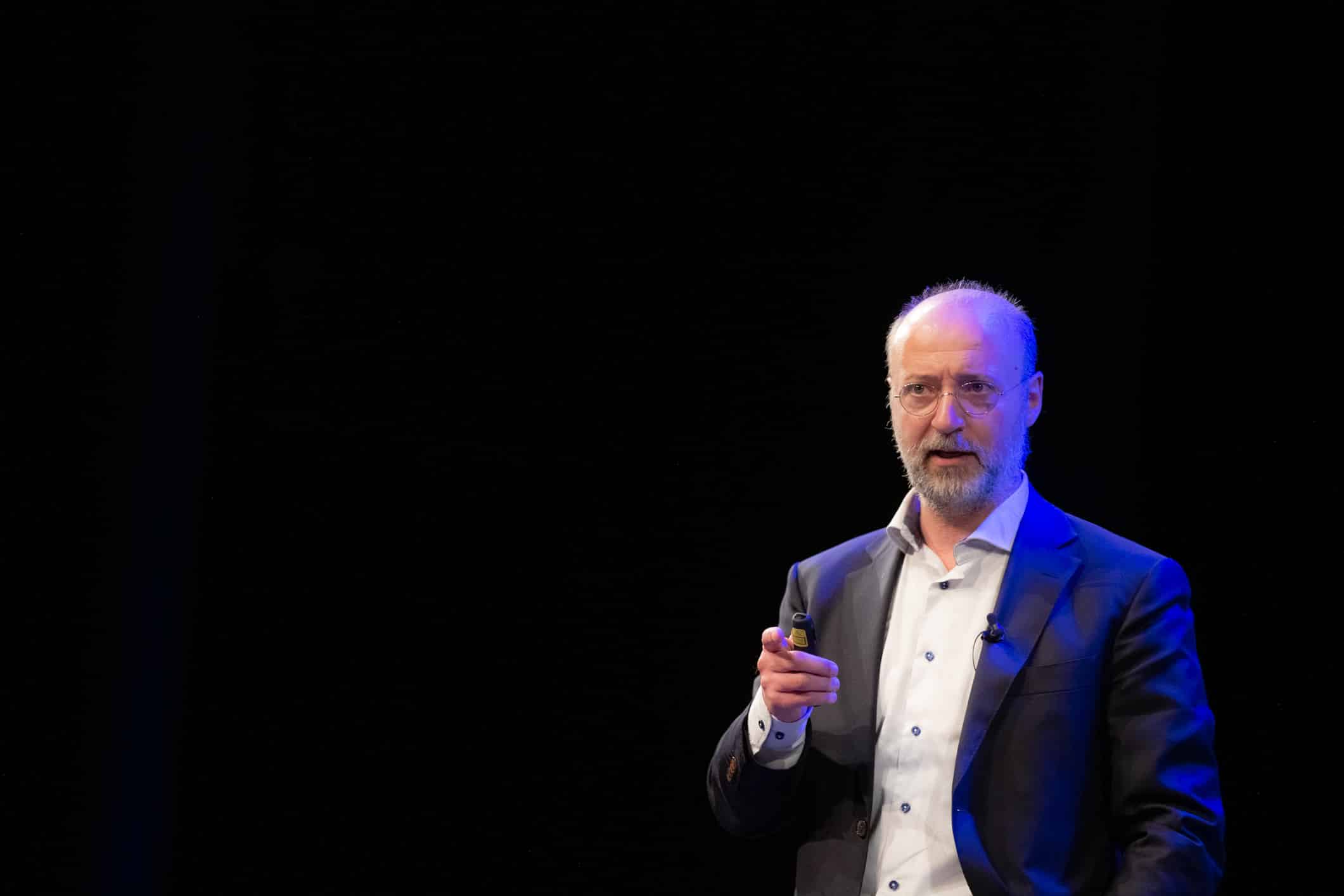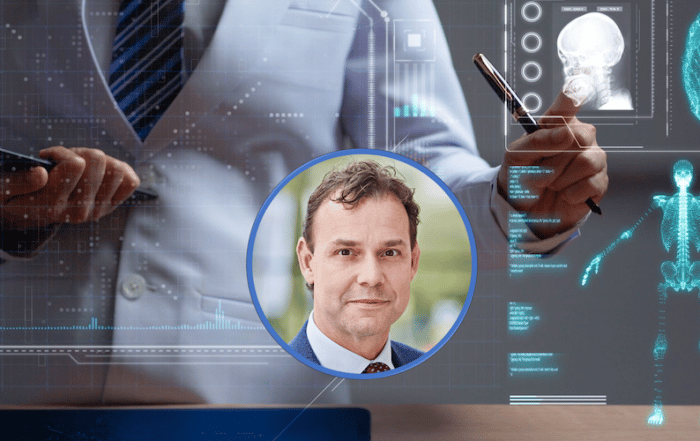Davide Iannuzzi helpt academici impact maken met onderzoek
Ervoor zorgen dat de universiteit haar onderzoeksresultaten inzet voor het welzijn van de samenleving. Dat is de missie van Davide Iannuzzi, de nieuwe Chief Impact Officer van de VU. En ook: “Ondernemende academici helpen academische ondernemers te worden”.
“We willen als universiteit geen ivoren toren zijn”, zegt Iannuzzi. “We willen samenwerken met burgers, politici en bedrijven. Inspelen op behoeften van de maatschappij en kennis co-creëren.” Deze drive om een proactieve bijdrage te leveren aan de samenleving zit achter de samenwerking tussen de VU en ons initiatief Smart Health Amsterdam. “We willen zorgen dat Amsterdam zich kan ontwikkelen op een manier die beter is voor burgers”, zegt Iannuzzi. Volgens hem biedt het ecosysteem van Smart Health Amsterdam kansen om “de stad leefbaarder te maken en te co-creëren met de stad en daarbuiten.”
Strategie voor valorisatie
Iannuzzi is hoogleraar natuurkunde aan de VU en werd er begin 2022 Chief Impact Officer. De functie is in het leven geroepen om valorisatie en ondernemerschap binnen de universiteit te versterken. Valorisatie gaat over het praktisch benutten van kennis die is opgedaan in onderzoek. Bijvoorbeeld voor maatschappelijke doeleinden, zoals kennis delen met een breed publiek. Of in de samenwerking met overheden. Of voor economische doelen, zoals het opzetten van start-ups en patenten verkrijgen. Het doel van Iannuzzi’s functie: “een cultuurverandering teweegbrengen die zorgt dat valorisatie even belangrijk wordt als de andere twee missies van de universiteit – onderzoek en onderwijs.”
VU Amsterdam heeft universiteitsbreed een strategische valorisatiestructuur opgezet, met binnen elke faculteit een verantwoordelijke. “Ik ben slechts het eindpunt”, zegt Iannuzzi. “Mijn rol is om ervoor te zorgen dat dingen hier aan de VU goed werken, dat we een goede strategie hebben die onderzoekers in staat stelt verandering teweeg te brengen. Het is ook een extern gerichte rol, waarmee we de kansen aanpakken die we hebben en goede relaties met onze omgeving creëren en samenwerken met bijvoorbeeld de Universiteit van Amsterdam en de Hogeschool van Amsterdam.”
Lees verder onder de foto

Davide Iannuzzi, Chief Impact Officer en hoogleraar natuurkunde, Vrije Universiteit
Juiste voorwaarden creëren voor impact
Iannuzzi wil de juiste voorwaarden scheppen voor academici om impact te maken en heeft duidelijke ideeën over hoe dat moet gebeuren. Onderzoekers moeten worden gesteund en er is een coherent beleid nodig om degenen te belonen die aan valorisatieactiviteiten werken. “Ik ben er sterk van overtuigd dat gedrag volgt op structuur. Als je wilt veranderen hoe mensen zich gedragen, als je een echte culturele verandering wilt, moet je de juiste structuren opzetten.”
Dit houdt in dat je valorisatie echt op één lijn moet stellen met onderzoek en onderwijs. “Je kunt iemand niet straffen omdat hij aan valorisatie doet en daardoor minder aan onderzoek en onderwijs. Als we er echt voor willen zorgen dat valorisatie op hetzelfde niveau komt als onderzoek en onderwijs, dan moeten we ervoor zorgen dat we mensen belonen die zich richten op valorisatie. Daar wordt momenteel veel over gediscussieerd, en er is een beweging gaande in de richting van het veranderen van de manier waarop we onderzoekers evalueren.”
Geldproblemen
Maar de diepere kwestie, zegt hij, is het feit dat valorisatie geld kost. Er zijn maar heel weinig universiteiten in de wereld die meer verdienen dan ze aan valorisatie uitgeven. Aandringen op rendement voor investeringen zal niet werken. “Universiteiten creëren waarde”, zegt Iannuzzi. “Investeerders en ondernemers voegen daar vervolgens waarde aan toe. Maar die waarde wordt pas aan het eind van het valorisatieproces gemunt, en de universiteit ziet niet veel terug van die waarde. Ik doel niet alleen op financiële waarde, maar ook het aantal gecreëerde banen, de ontwikkeling van nieuwe technologieën, de brains die naar Nederland worden gehaald, enzovoort. Onderzoek en onderwijs worden door de staat gesubsidieerd. Valorisatie grotendeels niet.”
Risico delen
Demonstrator Lab
Iannuzzi’s eigen ondernemerscarrière begon in 2006, toen hij een idee patenteerde dat gebaseerd was op de toepassing van een van zijn eigen uitvindingen. Na vijf jaar onderzoek en ontwikkeling lanceerde hij zijn bedrijf in 2011. Onderzoekers en academici begonnen naar hem toe te komen voor advies over hoe ze hun werk op de markt konden brengen. “De vragen waren allemaal hetzelfde. Dus vroeg ik me af: hoe kunnen we onderzoekers systematisch ondersteunen in dit proces?” Het antwoord op die vraag was de lancering van het Demonstrator Lab van de VU in 2016, een ruimte waar volgens de website ‘ondernemende academici academische ondernemers’ worden.
Speelplaats voor studenten en onderzoekers
Het Lab ondersteunt mensen die een idee willen omzetten in een tastbaar product of dienst. Het is niet alleen een hulpbron voor de VU maar ook voor andere partners van Smart Health Amsterdam: de HvA, de UvA en Amsterdam UMC. Iannuzzi omschrijft het als “een soort speeltuin waar studenten, onderzoekers en medewerkers het ondernemersspel kunnen spelen. Zo zien ze in een heel vroeg stadium of ze dat leuk vinden of niet.” Het Lab biedt faciliteiten waar mensen hun ideeën kunnen testen, prototypes kunnen bouwen en in contact kunnen komen met potentiële samenwerkers. Iannuzzi benadrukt dat de lat voor deelname extreem laag ligt: “Bijna iedereen kan meedoen, zolang ze maar een idee hebben dat niet in strijd is met de wetenschap.” Meer dan 100 verschillende projecten hebben tot nu toe gebruik gemaakt van het Lab, en 22 daarvan zijn nu geregistreerde bedrijven.
Successen…
Succesvolle ideeën uit het Lab variëren van een bokszak die atleten feedback geeft over hun prestaties tot een AI-algoritme dat scout naar nieuwe technologieën om problemen van commerciële bedrijven op te lossen. Iannuzzi is ook enthousiast over een nieuwe oplossing voor de gezondheidszorg die het Lab heeft verlaten en in ziekenhuizen is geïntroduceerd. De innovatie, bedacht door een VU-onderzoeker, maakt gebruik van tweede en derde harmonische beeldvorming: een techiek om biologisch weefsel te onderzoeken en analyseren. Het instrument wordt in de operatiekamer geplaatst, zodat wanneer een chirurg verdacht weefsel verwijdert, dit direct kan worden onderzocht in plaats van dat het naar een pathologisch laboratorium moet worden gestuurd voor analyse. “Ze kunnen het weefsel ter plaatse goed beoordelen”, legt hij uit, “omdat het een uiterst snelle techniek is met een zeer hoge resolutie. Dus in plaats van de patiënt dicht te maken en te wachten, kan de chirurg meteen kijken naar wat er is weggenomen en beslissen wat hij verder moet doen.”
…en mislukkingen
Veel projecten in het Demonstrator Lab mislukken. Volgens Iannuzzi is dat onvermijdelijk bij het leren over ondernemerschap. Het hoort erbij. “Misschien faal je de eerste keer en slaag je de tweede keer, of misschien faal je ook de tweede keer en slaag je de derde keer. Dat is geen probleem.” Volgens hem zijn er twee belangrijke obstakels voor succes. De eerste is het niet begrijpen dat een idee en een product twee verschillende dingen zijn. “Studenten zijn daar flexibeler in,” zegt hij, “maar veel onderzoekers komen binnen en zeggen: nou, mijn idee is perfect. Iedereen zal het kopen. En dat is verkeerd. Het gaat niet gebeuren. Het idee is misschien 10% van het succes. De manier waarop je dat idee op de markt brengt, maakt het verschil.”
Het tweede obstakel is de samenstelling van het team dat aan een idee werkt. Iannuzzi erkent dat dit als een clichématige opvatting kan worden gezien, maar is er stellig van overtuigd dat het wel degelijk zo is. “Je begint met het enthousiasme van een groep vrienden, en als het dan niet zo goed begint te gaan, valt het team uit elkaar. Een goed uitgebalanceerd team hebben dat veerkrachtig is, is fundamenteel voor succes.” Geluk en timing spelen ook een rol en Iannuzzi waarschuwt dat veel mensen onderschatten hoe moeilijk het is om als ondernemer succes te boeken. “We zien die voorbeelden van studenten die enthousiast worden, ze hebben iets in hun garage gedaan en ze komen heel enthousiast naar ons toe. Maar dan wordt het moeilijker en moeten ze het tempo opvoeren en meer tijd besteden aan de ontwikkeling van hun idee.” Een student, herinnert hij zich, gaf zijn project op omdat hij op vakantie wilde gaan.
Ondernemers-trechter
Iannuzzi ziet het Demonstrator Lab als de eerste stap op een pad dat van de academische wereld leidt naar wat hij omschrijft als “de klif van de vallei des doods” – het punt waarop innovatoren de sprong moeten wagen naar een hardere, meer concurrerende omgeving. Hij benadrukt het belang van een geïntegreerde trechter die beginnende ondernemers kan ondersteunen op de reis van idee tot product. Als voorbeelden noemt hij initiatieven als het 10K-programma van de HvA, de ACE Incubator en de Startup Hub van de VU en het Startup Village van de UvA. Iannuzzi is een groot voorstander van meer samenwerking tussen universiteiten, financiers en anderen om deze ondernemers-trechter te creëren, iets wat het Smart Health Amsterdam ecosysteem ondersteunt. “We creëren puzzelstukjes en voegen die samen, en Smart Health Amsterdam is zeker een puzzelstukje dat ons helpt co-creëren en met elkaar in contact te komen.”
14 juli 2022
Meer weten over
Neem contact op
Blijf jij ook op de hoogte?
8x per jaar nieuws en events uit de regio: schrijf je in voor de Board Update nieuwsbrief
Deel dit artikel
Wil je op de hoogte blijven?
Volg ons dagelijks op LinkedIn en schrijf je in voor de Board Update nieuwsbrief.
Lees ook deze berichten
- Met de selectie van vier kanshebbers is de regionale voorronde van de ...
- Met meer dan 80 ondernemers, 40 investeerders en diverse dienstverleners bood LSH Capital Match ...
- In tijden van geopolitieke spanningen, technologische revoluties en politieke onzekerheden is het ...




